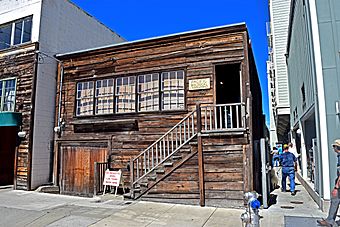Pacific Biological Laboratories facts for kids
Quick facts for kids |
|
|
Pacific Biological Laboratories
|
|

The Pacific Biological Laboratories of Ed Ricketts, on Cannery Row, Monterey, California.
Pacific Biological Laboratories logo of Ed Ricketts
|
|
| Location | 800 Cannery Row, Monterey, California |
|---|---|
| Area | less than one acre |
| Built | 1937 |
| Architect | Oneweiler |
| NRHP reference No. | 94001498 |
| Added to NRHP | December 29, 1994 |
Pacific Biological Laboratories, also known as PBL, was a special company that sold preserved animals and tiny microscope slides to schools and museums. Many of these specimens were aquatic creatures from the ocean. The lab was located in Monterey, California, on a famous street called Cannery Row.
The building and its work became famous because of writer John Steinbeck. He wrote about it in his novel Cannery Row, calling it "Western Biological Laboratory." A character in the book was based on one of the lab's founders, Ed Ricketts. After a fire in 1936, Steinbeck even helped the lab financially.
Contents
The Lab's Early Days
The Pacific Biological Laboratories company started in 1923. It was founded by Ed Ricketts and his college friend, Albert Galigher. They first set up the lab in Pacific Grove, California.
Around 1930, the lab moved to 740 Ocean View Avenue in Monterey, California. At this time, Ed Ricketts became the only owner. Today, this location is known as 800 Cannery Row.
A Fire and a Friend
On November 25, 1936, a big fire broke out next to the lab. Most of the lab's contents were destroyed. Luckily, a book manuscript written by Ricketts, Between Pacific Tides, was safe. It had already been sent away for publishing.
After the fire, the lab needed help. John Steinbeck stepped in to save it. He bought half of the company's stock, which helped the lab get back on its feet.
A Place for Big Ideas
The lab became more than just a business. It was a popular meeting spot for smart and creative people. Many artists, writers, and thinkers gathered there. Famous visitors included Joseph Campbell, Henry Miller, and, of course, John Steinbeck. They would discuss their ideas and share their work.
Specimens and Science
Ed Ricketts created his first scientific publication, which was a catalog. This catalog showed photographs and drawings of marine animals. It was meant to advertise the lab's specimens. However, it also became one of the first detailed records of the sea creatures found in Monterey Bay.
The lab's commercial work slowed down when World War II began. But the specimens collected by PBL are still important today. Many museums across the United States have specimens collected by Ricketts. These include the Field Museum in Chicago and the Smithsonian Institution.
Saving the Lab Building
In 1949, the Pacific Biological Laboratories building was sold to a local grocer named Yock Yee. Later, in 1956, a high school teacher named Harlan Watkins bought the building.
In 1958, a group of Watkins' friends bought the building together. They called themselves "Pacific Biological Laboratories." This group used the building as a weekly meeting place. Many of them were well-known artists and writers from Monterey. Some members even helped start the famous Monterey Jazz Festival in 1958.
The Pacific Biological Laboratories club sold the building to the City of Monterey in 1993. The building was later repaired in 1998 to make it stronger. The Cannery Row Foundation helped restore it and won an award for their work.
On May 14, 1997, a special plaque was placed at the lab's first location. This was to celebrate 100 years since Ed Ricketts was born. The Pacific Biological Laboratories building is now listed on the National Register of Historic Places. This means it is an important historical site.
Today, you can take tours of the building through the City of Monterey.



